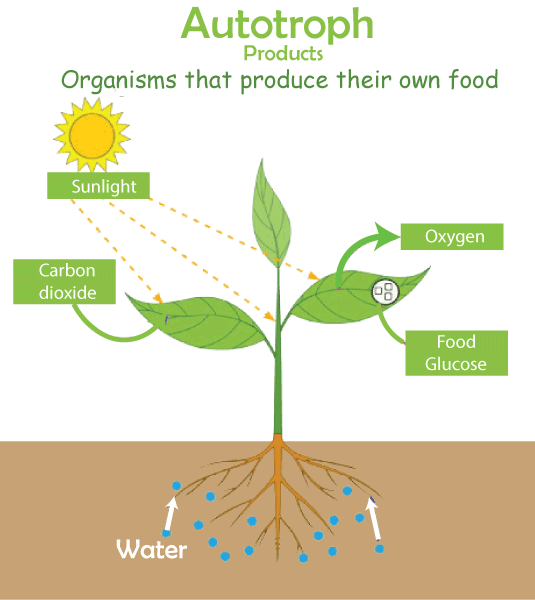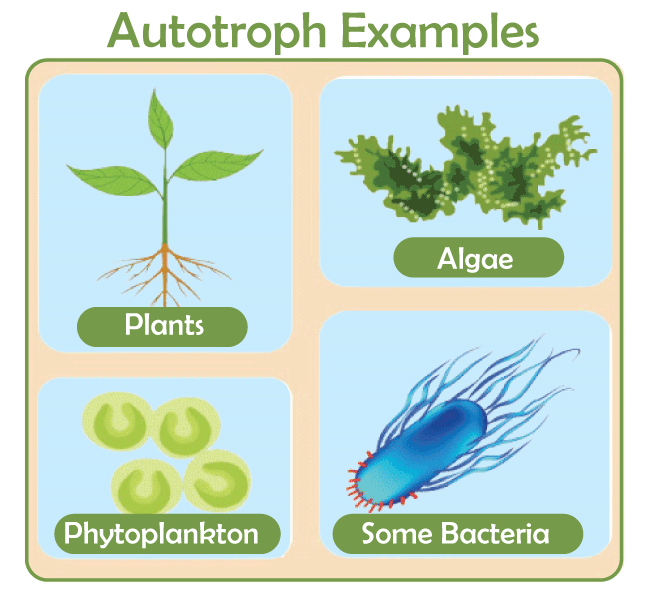Autotroph DefinitionAutotrophs are organisms that can produce their own food while drawing energy from inorganic materials. The Greek words "auto" for self and "trophe" for sustenance are the origin of the word "autotroph." Since autotrophs are an ecosystem's main energy producers, they serve as the foundation of the food chain and supply energy to all other creatures. 
Types of AutotrophThere are several different types of autotrophs, each with its own unique adaptations and strategies for capturing and using energy. 1. PhotoautotrophsThe most prevalent and well-known variety of autotroph is the photoautotroph, which is what most people are familiar with. They carry out photosynthesis, which uses solar energy to create organic chemicals like glucose. Chlorophyll and other pigments are employed in this process to absorb light energy, which is subsequently used to split water molecules and produce oxygen as a byproduct. As a result, organic molecules are produced, and these compounds serve as energy sources for both the plant and other animals that are part of the food chain. 2. ChemoautotrophsChemoautotrophs, a distinct subclass of autotroph, are able to generate their own food utilising the energy from inorganic molecules like ammonia, sulphur, and hydrogen. Normally, they can be found in hostile habitats like deep-sea hydrothermal vents and caverns. Chemoautotrophs may generate energy from the oxidation of inorganic molecules, and they subsequently use that energy to create organic substances like sugars and amino acids. 3. LithoautotrophsChemoautotrophs known as lithoautotrophs are able to obtain energy from inorganic materials like minerals and rocks. Geothermal springs, hot springs, and hydrothermal vents are typical places to find them. Lithoautotrophs are able to obtain energy from these inorganic substances utilising specific enzymes and metabolic pathways, which is then utilised to generate organic chemicals like glucose. 4. MixotrophsAutotrophs that can use both organic and inorganic substances as energy sources are known as mixotrophs. They frequently inhabit places with sparse or constrained energy sources, including the deep oceans or soils with little nutritional content. Mixotrophs can adapt to a variety of situations because they can switch between various metabolic pathways according to the availability of energy sources. 5. CAM PlantsA form of photoautotroph that is adapted to dry and semi-arid settings are CAM (Crassulacean Acid Metabolism) plants. By keeping their stomata closed during the day, which reduces the amount of carbon dioxide they can absorb, they are able to lessen water loss. Instead, they take up carbon dioxide at night, when it is cooler and more humid, and store it as an organic acid that can be converted into light during the day. With this adaptation, CAM plants can survive in dry settings by conserving water. 6. C4 PlantsA specific class of photoautotrophic plant known as C4 plants is adapted to situations with high temperatures and light intensities. In order to boost the effectiveness of photosynthesis, they are able to concentrate carbon dioxide in their leaves through a particular mechanism. C4 plants have an adaption that enables them to create more energy than other plant types in hot climates, which makes them suitable for tropical and subtropical areas. 7. HalophytesAutotrophs known as halophytes are adapted to high-salinity habitats like salt marshes and saline soils. By storing salt ions in their tissues, which serve to maintain water balance and fend off dehydration, they are able to survive in these conditions. Moreover, halophytes have unique enzymes and metabolic pathways that enable them to utilise solar energy for the synthesis of organic compounds even in highly salinized conditions. 8. Acidophilic AutotrophsChemoautotrophs known as acidophilic autotrophs are adapted to acidic settings including volcanic lakes and acid mine drainage. These habitats are rich in inorganic substances like iron and sulfur, which they can use to obtain energy. Acidophilic autotrophs can use these inorganic chemicals as energy sources and can survive in extremely acidic environments thanks to specific enzymes and metabolic pathways. 9. Hydrogen BacteriaChemoautotrophic hydrogen bacteria are able to use hydrogen gas as a source of energy. They are often found in places where anaerobic respiration produces hydrogen gas, such as anaerobic sediments and deep marine vents. Specialized enzymes and metabolic pathways enable hydrogen bacteria to absorb energy from hydrogen gas and use it to synthesise organic molecules. Examples of AutotrophsAutotrophs are organisms that can produce their own food using inorganic substances as a source of energy. They form the base of the food chain in many ecosystems, providing energy for all other organisms. Here are some examples of each type of autotroph: 
PhotoautotrophsThe most well-known photoautotroph is a plant, which is why it is called that. They utilise chloroplasts to absorb sunlight and photosynthesis to transform it into energy. As a result of this process, glucose and oxygen are produced, which are then utilised by the plant as a source of energy and discharged into the atmosphere, respectively. Algae - An extensive class of creatures, algae are found in a wide range of habitats, from freshwater ponds to the deep ocean. In a manner similar to plants, they use chloroplasts to absorb sunlight and convert it into energy through photosynthesis. Cyanobacteria - Cyanobacteria are a type of bacteria that are capable of photosynthesis. They are often found in freshwater environments, where they can form large colonies that are visible to the naked eye. Some protists - Some protists, such as euglenoids and diatoms, are capable of photosynthesis. They are important producers in aquatic ecosystems and form the base of the food chain for many organisms. ChemoautotrophsCertain bacteria are chemoautotrophs. Chemoautotrophic bacteria use chemical processes to generate energy. For instance, methane bacteria oxidise methane while sulphur bacteria use hydrogen sulphide as a fuel source. The settings in which these bacteria can be found range from deep-ocean hydrothermal vents to underground caverns. A few archaea - A few archaea are chemoautotrophs as well. For instance, certain species of methanogens employ hydrogen gas as an energy source and carbon dioxide as a source of carbon to generate methane. The carbon cycle in many ecosystems depends on these archaea. In addition to these examples, there are many other organisms that are capable of autotrophy. For example, some fungi are capable of producing their own food using chemoautotrophic pathways, while some animals have symbiotic relationships with autotrophic organisms. For example, some species of coral have a symbiotic relationship with photosynthetic algae, which provide them with energy and nutrients. Importance of Autotrophs in Food Chain
The provision of ecosystem services that are crucial for human well-being is another significant role for autotrophs. They control the water cycle, stop soil erosion, and contribute to the sanitization of the air and water. Overall, autotrophs play a critical role in the food chain as they form the basis of most ecosystems. Without autotrophs, there would be no energy available for heterotrophs to consume, and the entire ecosystem would collapse. Understanding the different types of autotrophs and their adaptations to different environments is important for understanding the ecology of different ecosystems and for developing strategies for the conservation and management of these ecosystems.
Next TopicDividend Definition
|
 For Videos Join Our Youtube Channel: Join Now
For Videos Join Our Youtube Channel: Join Now
Feedback
- Send your Feedback to [email protected]
Help Others, Please Share










